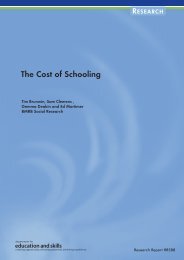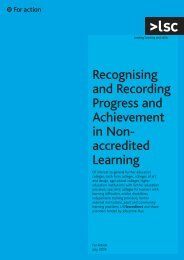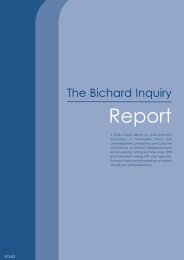Faiths and further education - Church of England
Faiths and further education - Church of England
Faiths and further education - Church of England
- No tags were found...
You also want an ePaper? Increase the reach of your titles
YUMPU automatically turns print PDFs into web optimized ePapers that Google loves.
11Models <strong>of</strong> college chaplaincy provision17Section 2 examines a number <strong>of</strong> important background issues insetting up a chaplaincy, from definitions <strong>of</strong> spirituality to differentroles involved in being a chaplain. It also raises the issue <strong>of</strong> thedifferent models <strong>of</strong> chaplaincy or faith teams which have beenfound in chaplaincies across the country. Some <strong>of</strong> these are morecharacteristic <strong>of</strong> the large inner-city colleges, others <strong>of</strong> the smallercolleges outside the major conurbations.The main models arebriefly set out below.18Chaplaincy was first developed in FE colleges in the 1970s <strong>and</strong>1980s.Two models predominated, both <strong>of</strong> which have been foundunsatisfactory as chaplaincy has developed <strong>and</strong> become more fullyintegrated into college provision over the past 10 to 15 years:• the ‘visiting vicar or minister’ model, in which the minister from alocal church – usually Anglican <strong>and</strong>/or Methodist – madeoccasional visits to the college, participated in festivals , collegeevents <strong>and</strong> so on, <strong>and</strong> hosted a carol service at Christmas• the ‘on-call’ model, in which the college maintains a list <strong>of</strong> localministers who were on call in case <strong>of</strong> need, in a studentemergency or other situation.• Half-time chaplaincy team leaders are becoming the mostcommon model, usually with an ecumenical <strong>and</strong>/or multi-faithteam, <strong>of</strong>ten mainly comprised <strong>of</strong> lay volunteers, although wherethere are significant minorities such as Muslims, some collegesare prepared to pay additional part-time hours for a Muslimchaplain, <strong>and</strong> even, in certain cases, male <strong>and</strong> female chaplains.Some half-time chaplain posts are combined with another half ornear half-time post with outside funding, such as regional ordiocesan FE or faith <strong>of</strong>ficer, chaplaincy <strong>of</strong>ficer, or an in-houseteaching or counselling post, enrichment activities co-ordinator<strong>and</strong> so on• Part-time team chaplaincies are probably the most commonmodel <strong>of</strong> paid chaplaincy, usually with a variety <strong>of</strong> fundingmechanisms <strong>and</strong> some volunteer input. In this model, thechaplaincy co-ordinator may be from a faith community or maybe a member <strong>of</strong> college staff with a particular interest inchaplaincy (in one or two cases, a student services co-ordinator)with a time allocation for this work• Part-time individual chaplaincies are either paid by the college,or by a church (usually an allocation <strong>of</strong> one or two days a week),or by a combination <strong>of</strong> the two. Some such chaplains have in thepast had advisory boards <strong>of</strong> ministers or other faith leaders or layvolunteers, but increasingly these are being integrated into thechaplaincy team.19Clearly the major problems for colleges with these models havebeen, first, the absence <strong>of</strong> a regular presence in colleges, <strong>and</strong>,second, that they are both church-based models, depending foreffectiveness on the goodwill <strong>of</strong> ministers with full-time churchposts in the neighbourhood. In mosques, gurdwaras <strong>and</strong> so on,leaders are mainly in full-time secular employment.The model isfast disappearing, <strong>and</strong> even where it has developed in a multi-faithform, it has rarely been found to work satisfactorily by eithercolleges or faith communities.20The more recent models <strong>of</strong> chaplaincy all include a permanentchaplaincy presence in college, <strong>of</strong> which the following are the mainvariants:• Full-time chaplains, with or without additional team membersfrom different denominations <strong>and</strong> faith communities, are foundin a number <strong>of</strong> larger colleges, with the college either paying thefull salary (usually partially defraying costs through a teaching orcounselling role)
















